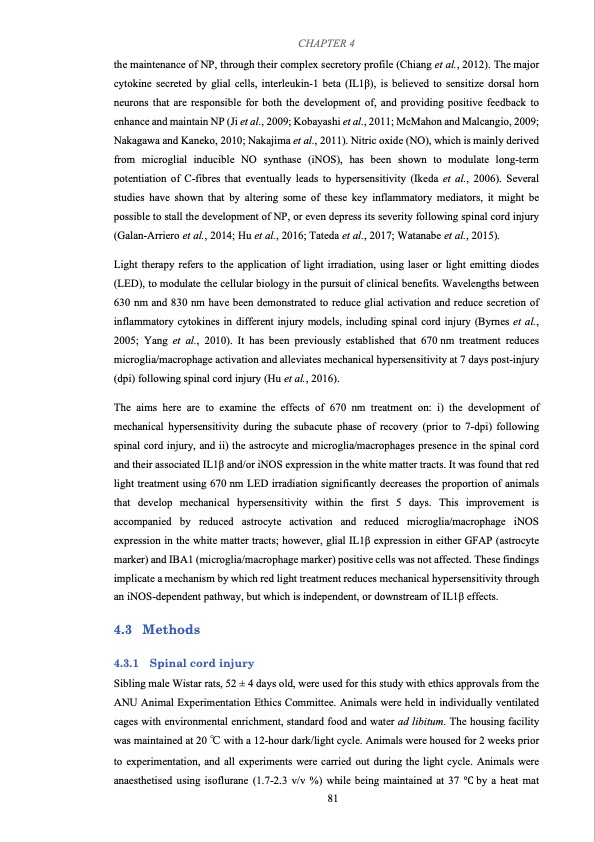
PDF Publication Title:
Text from PDF Page: 095
CHAPTER 4 the maintenance of NP, through their complex secretory profile (Chiang et al., 2012). The major cytokine secreted by glial cells, interleukin-1 beta (IL1β), is believed to sensitize dorsal horn neurons that are responsible for both the development of, and providing positive feedback to enhance and maintain NP (Ji et al., 2009; Kobayashi et al., 2011; McMahon and Malcangio, 2009; Nakagawa and Kaneko, 2010; Nakajima et al., 2011). Nitric oxide (NO), which is mainly derived from microglial inducible NO synthase (iNOS), has been shown to modulate long-term potentiation of C-fibres that eventually leads to hypersensitivity (Ikeda et al., 2006). Several studies have shown that by altering some of these key inflammatory mediators, it might be possible to stall the development of NP, or even depress its severity following spinal cord injury (Galan-Arriero et al., 2014; Hu et al., 2016; Tateda et al., 2017; Watanabe et al., 2015). Light therapy refers to the application of light irradiation, using laser or light emitting diodes (LED), to modulate the cellular biology in the pursuit of clinical benefits. Wavelengths between 630 nm and 830 nm have been demonstrated to reduce glial activation and reduce secretion of inflammatory cytokines in different injury models, including spinal cord injury (Byrnes et al., 2005; Yang et al., 2010). It has been previously established that 670 nm treatment reduces microglia/macrophage activation and alleviates mechanical hypersensitivity at 7 days post-injury (dpi) following spinal cord injury (Hu et al., 2016). The aims here are to examine the effects of 670 nm treatment on: i) the development of mechanical hypersensitivity during the subacute phase of recovery (prior to 7-dpi) following spinal cord injury, and ii) the astrocyte and microglia/macrophages presence in the spinal cord and their associated IL1β and/or iNOS expression in the white matter tracts. It was found that red light treatment using 670 nm LED irradiation significantly decreases the proportion of animals that develop mechanical hypersensitivity within the first 5 days. This improvement is accompanied by reduced astrocyte activation and reduced microglia/macrophage iNOS expression in the white matter tracts; however, glial IL1β expression in either GFAP (astrocyte marker) and IBA1 (microglia/macrophage marker) positive cells was not affected. These findings implicate a mechanism by which red light treatment reduces mechanical hypersensitivity through an iNOS-dependent pathway, but which is independent, or downstream of IL1β effects. 4.3 Methods 4.3.1 Spinal cord injury Sibling male Wistar rats, 52 ± 4 days old, were used for this study with ethics approvals from the ANU Animal Experimentation Ethics Committee. Animals were held in individually ventilated cages with environmental enrichment, standard food and water ad libitum. The housing facility was maintained at 20 °C with a 12-hour dark/light cycle. Animals were housed for 2 weeks prior to experimentation, and all experiments were carried out during the light cycle. Animals were anaesthetised using isoflurane (1.7-2.3 v/v %) while being maintained at 37 °C by a heat mat 81PDF Image | Effects of Red Light Treatment on Spinal Cord Injury

PDF Search Title:
Effects of Red Light Treatment on Spinal Cord InjuryOriginal File Name Searched:
Thesis_Di Hu_final.pdfDIY PDF Search: Google It | Yahoo | Bing
Cruise Ship Reviews | Luxury Resort | Jet | Yacht | and Travel Tech More Info
Cruising Review Topics and Articles More Info
Software based on Filemaker for the travel industry More Info
The Burgenstock Resort: Reviews on CruisingReview website... More Info
Resort Reviews: World Class resorts... More Info
The Riffelalp Resort: Reviews on CruisingReview website... More Info
| CONTACT TEL: 608-238-6001 Email: greg@cruisingreview.com | RSS | AMP |